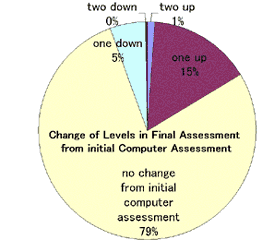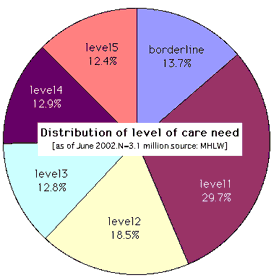|
Chapter 10. Long Term Care |
| In April 2000, the much-awaited Long-Term Care Insurance (LTCI) took effect. The new system will not only expand the long-term care services but also include some innovative aspects not seen in traditional health insurance system. |
|||||||||||||||||||||||||
| 1. Administrative structure | |||||||||||||||||||||||||
|
In contrast to the health insurance system, which has a fragmented structure with different insurers covering different segments of population, the LTCI system has a uniform structure: it is administered by municipal governments (there are three categories of municipal governments, namely cities, towns and villages depending on the population size). Municipal governments insure all residents aged 40 years or older where he or she resides. For example a 45-year-old male worker of Sony Corporation will be insured by SONY health insurance society for health insurance but will be insured by the municipal government where he resides for the LTCI. He will have to switch to different insurer for health insurance coverage if he switches the company but will continue to be insured by the same municipal government for the LTCI as long as he does not move somewhere else. Because all beneficiaries are consolidated to municipal governments, it became possible for municipal governments to draw a long-range plan to cope with the LTC. All municipal governments are required by the LTCI law to develop a strategic plan with 5-year time frame to make a sound actuarial prospect. Municipal governments also administer their own health insurance (NHI). However it is difficult for municipal governments to draw a long range plan because only a fragment of residents are insured by the municipal governments and the number of insured residents varies depending on the economic situation (for example, a huge lay off will deprive workers of health insurance coverage and they will migrate to the NHI system which are administered by municipal governments). |
|||||||||||||||||||||||||
| 2. Beneficiaries | |||||||||||||||||||||||||
|
As mentioned earlier, the LTCI does not cover the entire population. The beneficiaries are limited to people aged 40 years or over, or roughly half the population. This reflects the purpose of the LTCI law, which clarifies that the law is intended for disability caused by aging. Further the beneficiaries are divided into two categories: beneficiary I for elderly aged 65 or over and beneficiary II for people whose age is 40 to 64 years old. The distinction between the two categories is the difference of premium collection as discussed below. |
|||||||||||||||||||||||||
| 3. Financing | |||||||||||||||||||||||||
|
Although Japan's LTCI may be classified as social insurance, it is an amalgam of both German and British models in terms of financing, i.e. half of the finance comes from tax and the half comes from premium contribution. Insurance premium is levied on all beneficiaries but the method of levying varies between the two categories of beneficiaries. For the beneficiary I, most of whom are pensioners, the premium is withheld from their pension payment. For the beneficiary II, most of whom are working class, health insurers levy the premium by adding on the health insurance premium. There are a small number of beneficiary I who do not receive pension. They are required to pay voluntarily to the municipal government. Since more then 3200 municipal governments administer the LTCI system, the premium level also varies from municipality to municipality. The average monthly premium is approximately 3000 yen and ranges from 1500 to 5000 yen. In each municipality, the premium is scaled to the beneficiaries' income with 3 times difference between the lowest and the highest income bracket. |
|||||||||||||||||||||||||
| 4. Need Assessment | |||||||||||||||||||||||||
|
Unlike health insurance, the benefit of the LTCI will not automatically be granted just by showing the insurance card. To be eligible for the benefit, the beneficiary must apply to the municipal government for need assessment. Only after the person is assessed as disabled, he or she will be entitled to the benefit. A beneficiary must apply to the municipal government and the municipal government dispatches a surveyor to the applicant. The surveyors must be qualified care managers and on-site survey will be conducted using the uniform assessment tool, which consists of 73 survey items to measure ADLs, IADLs and behaviors. The surveyors may record any particular findings to be considered for final assessment but they have no authority to make any judgment. The recorded assessment tools will be evaluated by computer to give preliminary assessment [dismiss, borderline, level 1,2,3,4,5]. The municipal governments will also ask attending doctors who are designated in the application forms to submit their professional opinion. The need assessment review committees [NARC] consisting of around five health and welfare professionals will review the surveyors' findings and doctors' professional opinion to decide whether the preliminary assessment should be altered. What is important about the assessment process is that although NARCs have authority to make final assessment, they do not start their review from scratch. They decide WHETHER THE PRELIMINARY ASSESSMENT SHOULD BE ALTERED OR NOT by reviewing the surveyors' findings and doctors' opinion. In 80% of the cases, the preliminary assessment will be final. The need assessment is valid only for the specified period, usually 6 months. Beneficiaries must apply for renewals to stay eligible for the benefit.  |
|||||||||||||||||||||||||
| 5. Benefit | |||||||||||||||||||||||||
|
Benefit of the LTCI system is divided into institutional care and home care. The home care is characterized by integration of medical and non-medical care within the same individually assessed budgetary cap. Medical and non-medical services were not in a competitive relationship before the LTCI system was implemented: medical services were reimbursed by the Elderly Health Care system and non-medical services were financed by welfare system. However the LTCI system brought both sectors into a competitive relationship in which one's gain is another's loss, because they have to compete over the fixed "pie" of budgetary cap.
The monetary terms of benefit is metered to the level of care need. The level of care need will determine the per diem cost for institutional care and the monthly budget cap for home care as shown below:
|
|||||||||||||||||||||||||
| 6. Need Assessment Tool | |||||||||||||||||||||||||
|
Objective evaluation of the individual's eligibility for benefit was a premeditated policy throughout the design of the LTCI system. This reflects a bitter reflection over some of the drawbacks of the health insurance system, most prominent of which is the "medically unjustifiable" prolonged hospitalization. Because of chronic shortage of nursing home beds, many elderly who lack adequate care at home are institutionalized at geriatric hospitals without firm medical necessity. Although all health insurance claims are subject to rigorous review, such "medically unjustifiable" prolonged hospitalization is seldom denied payment chiefly because it is difficult to challenge the physicians' judgment without a objective evaluation tool. The German LTCI also has an assessment tool but Japan's tool is far more complex and sophisticated. An evidence-based approach was adopted to develop the assessment tool: a radical departure from traditional negotiation oriented policymaking. A field survey was conducted on a sample of residents of selected nursing homes to quantify the care need by means of one-minute time study and correlate it with ADL measurement. The methodology was in many ways similar to that of the U.S. with its development of MDS, RUGs. The product was the assessment tool consisting of 73 items that will predict the individual care need with certain accuracy. The tool is fully computerized to facilitate the assessment process and is now used nationwide to determine the eligibility for the benefit. |
|||||||||||||||||||||||||
| 7. Care Management | |||||||||||||||||||||||||
|
Another key policy of Japan's LTCI is care management. Care management is a professional service to coordinate different services provided by different providers to accommodate geographically dispersed home settings within a limit of allocated budget. The U.K. in its Community Care Act 1990 first implemented care management. This was part of the welfare reform promoted by Thatcher administration. Care management was expected to be important for Japan's LTCI system because the benefit includes not only non-medical services such as home help but also medical services such as visiting nursing services. This is a sharp difference from German LTCI, which provides purely non-medical services and therefore lacks official care management system. To cater to the need for need assessment and care management, a considerable number of skilled experts were needed. A new professional called "Care manager" was created and the first qualification exam was started in September 1998. Already three exams were held and the number grew to over 200,000. Qualification will be given professionals who already possess health or welfare related licenses and have at least five years of clinical experience. |
|||||||||||||||||||||||||
| 8. Experience in the two Years | |||||||||||||||||||||||||
As more and more beneficiaries become familiar with the new system, the number of beneficiaries who applied for need assessment and qualifies for the benefit also increased gradually. As of June 2002, approximately 3.1 million beneficiaries were assessed as eligible for the benefit. This figure is approximately 13% of the total beneficiaries I (23.1 million). The distribution of level of care need is shown in the graph below: |
|||||||||||||||||||||||||
 
|